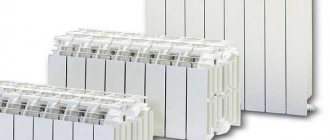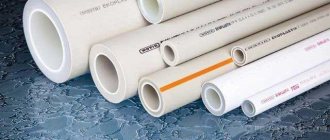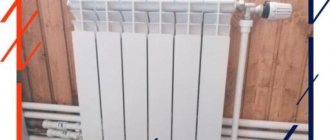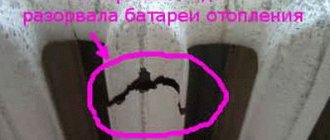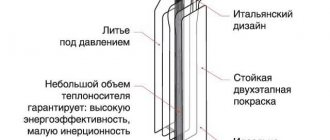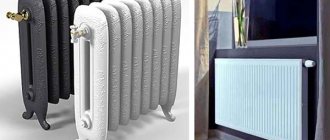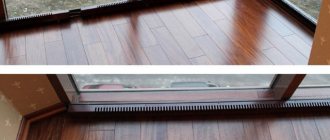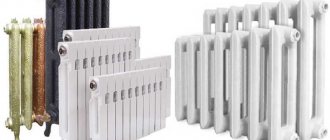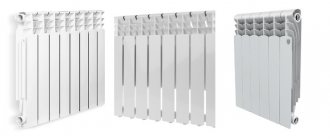A panoramic window is the dream of many. Just imagine a beautiful view from the window of the garden, or the lights of the night city at your feet, clouds running across the sky, and a wide view of the streets or nature. In addition, a room with a panoramic window looks much lighter, more spacious and more interesting than ordinary small windows. In apartment buildings and private estates, huge windows from ceiling to floor are increasingly being installed. Everything is fine in them if the heating is organized correctly. Everyone knows that the larger the area of glass compartments, the higher the level of heat loss.
Types of structures
Depending on the material used for the production of radiators, several types of devices can be distinguished.
- Aluminum and cast iron. These are perhaps the “oldest” versions of radiators, which were first presented to consumers at the beginning of the last century. However, it is quite difficult to find floor products made of these metals; conventional batteries are much more common, which are simply attached to the floor using brackets. We can say that these are ordinary wall-mounted models that are simply attached to the floor.
- Bimetallic radiators. This type of heating devices includes those made of two metals; aluminum-copper and aluminum-steel are more common. The features of such radiators include the following point: the water inside them moves along a special core made of steel and characterized by high corrosion resistance.
- Steel. This version of radiators is quite widespread; convectors, registers and tubular models are made from this alloy. Convectors are characterized by the same design as their counterparts made of aluminum and copper, however, with the same dimensions, the degree of heat transfer of steel models is slightly lower.
Tubular modifications can have a wide variety of configurations, due to this they are often used not only for effective heating, but also as a decorative element in the room, a stylish accent of a modern interior. The registers look like the most basic homemade installations, they are produced quite quickly: thick pipes are simply connected to each other using special jumpers, which forms a closed circuit at the output. Such products can be used as an element of the heating system or autonomously.
Separately, you need to dwell on the types of heaters inside floor radiators.
Depending on the principle of operation, they are divided into electric and water.
- The first varieties work due to a special closed heating element on which metal plates are held; they can be copper or steel. The purpose of such discs is to maximize the surface area in contact with the air flow. Such radiators are characterized by a high degree of safety, since they are equipped with fuses for effective and reliable protection against any possible malfunctions in the electrical network.
- The operating principle of water models is slightly different. The main heating element here consists of metal pipes with several plates, which are attached to a centralized heating network using special pipes.
Depending on the type of model, a floor radiator may include a fan, this significantly increases the heat transfer of the device. Such a radiator operates from an electric current network and is supplemented with special vibration-proof supports, which greatly reduce the level of noise emitted.
For owners of non-standard rooms, radiators of a wide variety of shapes and the required radius of curvature can be manufactured according to individual projects. If you plan to use the device in homes with high humidity levels, then you should give preference to models made of stainless materials with a built-in drain for drainage. Some models have special electronic regulators that allow you to set the optimal temperature background. As a rule, a remote control is included with such products.
Criterias of choice
Water systems are more difficult to work with; several additional factors may influence the purchasing decision, in addition to the dimensions and material from which the body, fins and pipes are made.
The first thing you should pay special attention to is the overall pressure level in the heating system. For private buildings and cottages, absolutely any model will do, since the pressure here rarely exceeds 3 atmospheres
But owners of apartments in high-rise buildings should add pressure testing and operating pressure of the heating system. Experts recommend installing devices rated at 15 bar. Coolant parameters. Here the approach is similar: for individual heating systems, a variety of designs can be used, since only the owners of the house set the required temperature conditions, but the owners of apartments in high-rise buildings are forced to adapt to what flows in their pipes. Moreover, this concerns not only the degree of heating, but also the presence of all kinds of suspensions, oxygen content and connection method. Therefore, it would be right to first get acquainted with the recommendations for specific types of coolant, and then compare them with the parameters of the heating device.
Type of system and connection diameter Most often, varieties of floor radiators are equally effective in both single-pipe and double-pipe systems, however, there is no rule without exception, so it is necessary to pay attention to this point
The diameter should also be taken into account, but this factor cannot be considered critical, since nowadays the market is overflowing with all kinds of adapters, so any sizes can be “adjusted” to each other. It is very important to think in advance what material the radiator should be made of under specific operating conditions. If the room is dry, then you should not purchase a product with a stainless steel body, since the quality of such material sometimes raises serious doubts. Of course, world-famous brands produce their heaters only from the best steel, but cheaper analogues often use so-called technical stainless steel, which significantly loses in its performance characteristics.
Main characteristics
Floor radiators are heat-generating equipment that is installed so that technical elements are not visible. The design of the radiator is quite simple and consists of a box made of stainless steel. Inside it has heat exchangers consisting of copper and aluminum. To connect radiators built into the floor, corrugated tubes made of corrosion-resistant materials are used. A distinctive feature of the device is that there is no gap at all between the plates and the circuit.
Such designs come with or without housings. Both options are quite easy to install. Before installation, you need to prepare a gutter that matches the length of the radiator. Then the device itself is placed in it, and only after that the radiator is connected to the communications. Radiator sizes range from 90 centimeters to three meters. This allows you to choose an option that will fully correspond to the selected room. That is, it will be able to fully heat it, and at the same time will not take up too much space in the room.
What is meant by “French windows”
This term has a broad concept, let us comment on the context in which this article will be.
- Option one - French windows or glazing means dismantling the outer wall of the house/balcony, loggia and installing windows in the “floor”. That is, in fact, there is a street outside this window.
- The second option involves dismantling the window sill block and installing double-glazed windows. But this is not the front of the house. Behind these double-glazed windows there is a loggia or balcony. That is, we do not change the facade and the outside façade of the house remains untouched.
Radiators for panoramic windows
In this article we will look at the main options for heating rooms with panoramic windows, their advantages and disadvantages. Large, wide floor-to-ceiling windows create a unique atmosphere in the house: they fill the room with light and open up a stunning view. At the same time, modern energy-saving double-glazed windows make it possible to use panoramic windows even in Russian conditions. It is not surprising that this architectural solution is gaining increasing popularity. But at the same time, it requires more careful planning of upcoming repair work.
In-floor convectors for panoramic windows
Most often, heating of such premises is assigned to in-floor convectors. This is the most obvious and simple solution from a design point of view: the convector is not conspicuous, does not block the view from the window, and at the same time is located directly under the window, reliably protecting the window from condensation. In-floor convectors are also convenient for interior designers: they may not take heating devices into account in their design, assuming that they will be invisible convectors in the floor. Most manufacturers provide the option of painting the decorative grille to match the color of the floor covering.
But in-floor convectors also have certain disadvantages that do not allow them to be called a universal solution:
- Firstly, it is not always technically possible to install them. For example, this may be due to too strict restrictions on the height of the convector, which makes it impossible to find a suitable model.
- Secondly, the design of convectors makes them difficult to clean: they quite easily collect dust, which is already difficult to remove from under the heat exchanger.
- Thirdly, in-floor convectors are a relatively low-power heating device. In most cases, they are not enough to fully heat the entire room. A solution could be to use forced convection convectors equipped with tangential fans, but this not only increases the overall cost of equipment and installation, but also negatively affects indoor comfort: constant slight noise from the fans, fine dispersive dust in the air, etc. .
In-floor convectors for panoramic windows.
Pros:
- Convectors fit well into the interior and do not block the view from the window
- Located directly under the window, convectors reliably protect the room from drafts and condensation on the glass
Minuses:
- It is not always possible to install convectors for technical reasons
- Trench convectors have low thermal power, which is why they can only be used in combination with other heating devices. Convectors with forced convection have high power, but they also have their own disadvantages.
- Like any convectors, trench convectors have dust removal pipes. Therefore, maintaining perfect cleanliness in the house will be more difficult.
Low radiators for panoramic windows
Another heating solution can be low floor radiators. They are more versatile - they can be installed with almost any pipe layout in the apartment and at any floor pouring height.
The main disadvantage of low radiators is that they partially block the view from the window, and in some cases may interfere with its full opening, as well as with washing the glass.
Pros:
- Radiators are located directly opposite the window - they protect the windows from condensation, as well as the room from drafts.
- Low floor radiators can be installed in almost any conditions: any pipe layout and floor height.
Minuses:
- Radiators partially cover the panoramic window
- Low radiators will also interfere with opening the window (if provided for by its design), and also, in some cases, with washing the window.
Radiators next to windows
An interesting design solution could be radiators located next to panoramic windows. In this case, the radiators evenly heat the room without covering the window. The main disadvantage here is the non-optimal location of the heating radiators.
Pros:
- In most cases this is the cheapest option
- Wide choice in the location of the radiator, as well as in the choice of radiator model
- Radiators are easy to clean
Minuses:
- The radiator does not block the flow of cold air from the side of the window, as a result of which the temperature near the window may be lower than in the rest of the room
- In some cases, condensation may form on the glass, but this is more likely a matter of insufficient ventilation or poor quality of the glass unit.
Warm loggia
Warm loggia
Heated windows. Warm loggia. Warm balcony.
Modern architectural and construction solutions in the field of facade glazing can give any building a special look. Glass structures allow the architect to realize the most original and non-standard projects, and looking at the appearance of urban new buildings, it becomes obvious that the use of glass structures by developers is the most popular trend. This is explained by the fact that façade glazing technology allows you to expand the usable area of residential premises, increase visibility and add natural light to them. The glazed facade gives the house originality and makes it stand out against the backdrop of typical buildings.
Heating of windows and heating of rooms with panoramic glazing.
The appearance and design of heating devices in rooms with stained glass windows, from the point of view of design and functional efficiency, is important, since heaters that are inconsistent with the architectural design can completely destroy it. Conventional panel or aluminum radiators are not suitable in this case.
The reason is not only that they will not fit into the overall design, both internal and external, but also because the surface of the glass is the coldest in the entire room and condensation is likely to form on it. For example, in the kitchen the relative humidity level can reach up to 80%. The dew point value is 18-19°C. If the temperature on the surface of the window is at least 3 °C above the dew point, i.e. about +21 - +24 °C, then the windows will not fog up, in other words, “cry”. Accordingly, in order to prevent condensation from falling on the glass, it is most rational for heating devices to be located along the entire perimeter of the glazing, creating a continuous thermal curtain. Heating windows using warm baseboards is most effective. Warm air rising in a continuous stream along the entire perimeter of window structures will create a reliable thermal barrier and will not allow moisture to condense on the inner surface of the glass.
Warm loggia. Warm balcony.
How to make a loggia warm? Let's consider a popular trend in apartment redevelopment - combining a loggia with an adjacent room, living room or kitchen. Combining a loggia with an apartment is an excellent solution to increase usable space, especially if the dimensions of the apartment are small. Such a reconstruction usually entails special measures to improve the quality of windows, additional insulation of walls, floors and ceilings, since the thermal resistance of enclosing structures should not be lower than building standards (see SNiP thermal protection of buildings). Are you interested in preventing the heat on the balcony from escaping onto the street? Then you can’t do without reliable thermal insulation
Insulating the loggia is very important, since an insufficient level of thermal insulation of the fences will lead in the future to dampness, condensation, the formation of mold, and disruption of the microclimate in the room combined with the loggia, so it is better not to save on insulating loggias and balconies
But insulating the loggia is not all. Thermal insulation is like a person’s clothing; it prevents heat from escaping, but does not produce it. In order for a loggia or balcony to become truly warm, heating must be installed there. The loggia becomes part of the living space, which means the total amount of heat loss will increase, and the heating devices installed in the room initially were not designed for the connected volume and heating the loggia will require additional thermal power. Heating a loggia, taking into account the specifics of the room, will be especially effective using baseboard heating. Uniform heating of the inner surface of the walls will create an additional layer of thermal protection, preventing the formation of dampness in the corners and condensation on the windows.
Insulation of balconies and loggias in combination with installed warm baseboards allows you to achieve the required level of comfort in cold weather. Heating a loggia in urban conditions is most simply and quickly accomplished using the electric version of the baseboard system. A warm electric baseboard can be quickly installed even in winter, when the lack of heat on the loggia is especially noticeable, and electric heating does not require preparatory work.
Which radiators to choose for a wooden house
Heating a wooden house (we are talking primarily about log houses) indeed has its own characteristics, since the thermal conductivity of wood is low and depends on its species. In addition, it is necessary to ensure maximum fire safety. But in general, the issue of providing heat, as well as safety, rests primarily on the correct installation of the heating system, the choice of boiler and the number of radiators. There are no restrictions on the type of radiators here: steel, cast iron, bimetallic, aluminum - all of them can be used in a wooden frame.
Any type of radiator is suitable for a wooden house. Source pinterest.com
Average prices for services
In order not to damage expensive equipment, many owners turn to installation organizations. The cost of this work depends on the type of work and the selected equipment :
insulation of slopes, 600 rub./m.p.;- water “warm floor”, 20,000 rub./m.p.;
- electric “warm floor”, 14,000 rub./m.p.;
- warm baseboard, 8000 rub./m.p.;
- electric floor convector, 4800 rub./m.p.;
- high radiator, RUB 3,500/piece;
- low radiator, RUB 2,300/piece;
- electrically heated glass with maximum configuration, RUB 20,000. /1 m2.
Radiators built into the floor
The presence of floor heating devices built into the floor is indicated only by a decorative grille on the floor.
Floor heating radiators built into the floor provide an even more hidden installation of the heating system. From their name it is clear that they are installed directly in the floors, and the heat is released through a decorative grille installed flush with the floor covering. Such devices can be installed directly in doorways and do not interfere with passage.
The advantage of radiators built into the floor is their complete invisibility: only the decorative grille is visible from above. Due to this, they are often used in rooms with an exclusive design, where the presence of unnecessary and interfering elements is unacceptable. But the main disadvantage is that such devices are placed in special niches, which is why it is best to provide for their installation at the stage of building construction. Installing floor-mounted radiators in already built and finished buildings poses a big problem.
Models without housing
In this case, heating radiators are installed in a specially prepared niche. Its walls are insulated. The most commonly used is polyester foam. Batteries of this type are mainly located in new buildings, where their installation is provided for in the design documentation.
Diagram and principle of operation of a liquid electric radiator
The heating circuit is installed inside the niche at a height of 10 cm from the bottom. This is due to fire safety regulations. Also, the presence of an air gap improves the movement of warm masses and increases the efficiency of the heating device.
The channel with heating elements is closed with a special grille. It must withstand significant loads that are possible during operation.
Also, the grill must be removable so that the channel can be cleaned of accumulated dust. It can move completely away or collapse.
Kinds
Low radiators are a type of battery that differs from standard ones in its height. This parameter for such units is only 200-400 mm. Such devices are installed in rooms with large panoramic windows, in swimming pools, gyms, greenhouses, etc.
The main criterion on the basis of which types of low radiators are distinguished is the material of manufacture.
Cast iron
Batteries of this type are sections created by casting. Such devices have good thermal inertia and are resistant to corrosion. However, they have a low operating pressure, which reaches only 10 atm. In addition, they are very fragile. Users note that plaque often forms on the inner surface of the channels and dirt accumulates, which leads to a decrease in heat transfer. Therefore, you need to clean them periodically.
Steel
Steel panel radiators are constructed from one or more heating plates that are enclosed in a finned shell.
Their main positive characteristics:
- good thermal conductivity;
- low inertia;
- low coolant consumption.
Despite many good technical indicators, there are some disadvantages: such radiators cannot withstand water hammer and corrosion.
Reviews indicate that when water is drained, rust forms on the walls of the panels. Another disadvantage is that such heaters are not cheap. For example, if you want to purchase a radiator with a height of 300 mm, be prepared to pay from 2000 to 5000 rubles for it.
Aluminum
Low heating radiators made of aluminum have an attractive design, high heat transfer rates and are light in weight. They are characterized by high technical characteristics, thanks to which they are able to withstand operating pressures of up to 16 atm.
However, there are also some disadvantages. For example, aluminum radiators are short-lived: their service life is 10, in rare cases 15 years. Plus, such devices are not able to withstand hydraulic shocks, and as a result, leaks can form between sections.
The price of aluminum radiators varies from 300 to 1500 rubles.
Note! Aluminum batteries withstand water hammer better than cast iron ones, but their convection properties are much worse. Bimetallic
Bimetallic
The design of bimetallic models of low radiators consists of a core, which is made of steel or copper pipes, and an aluminum shell. Such batteries withstand high pressure well, consume a small amount of water and are resistant to corrosion processes.
Lamellar
Convector-type plate radiators are produced with the lowest heights; they can be attached to both the wall and the floor, and, if necessary, covered with decorative grilles. The devices have high heat transfer rates. The maximum pressure they can withstand is 20 atm. The disadvantage is that if there is a leak, it will not be possible to replace a part; you will have to buy a new radiator.
Aluminum
The lowest aluminum radiators have a height of 245 mm. The Sira campaign has such models. Alux 80 and Alux 100, Rovall 80 and Rovall 100, Swing. They have a good heat output for such miniature products - 89-97 W. Global has a low radiator - model Gl-200/80/D. This model is cast, with a working pressure of 16 bar.
The lowest radiator at Global Gl-200/80/D has a height of 200 mm
There are aluminum radiators with an interaxal distance of 200 mm from the Russian manufacturer, Rifar, Rifar Base 200 and Rifar Forza 200. Moreover, their back wall is solid. You can safely place them with your back to the window and not worry about the appearance from the street.
But these are the smallest radiators. There is a large selection of models, the height of which will not be higher than 45 cm. Every company has such sizes, in almost every line. A center distance of 300 mm, 350 mm or 400 mm also fits into the low category.
Advantages, disadvantages
Any line has low batteries, with an axial distance of 300 or 350 mm
Advantages of aluminum radiators: lightweight, have high heat transfer, small capacity (little water can be placed), and quickly respond to temperature changes.
The most important disadvantage is the chemical reactivity of aluminum and its softness. For normal and long-term operation, a high-quality coolant is required: Ph 7-8, operating pressure - from 5-6 Bar for extrusion models, to 10-12 for cast ones. It is imperative that the coolant contains a small amount of oxygen and suspended matter. Oxygen promotes the oxidation and destruction of aluminum, and suspensions wear down the metal.
But each manufacturer has its own requirements. For example, Chinese aluminum Radena radiators operate at 16 Bar pressure and coolant with Ph 6.5-9. And Sira extrusion models have a working pressure of 16 Bar and a warranty period of 25 years. There are probably other aluminum radiators whose characteristics go far beyond the average: and there are too many manufacturers and models.
When choosing, do not forget about all these technical subtleties: only if the operating conditions coincide with the manufacturers’ recommendations, the heating will work for a long time and without failures.
When installing the system, it is worth remembering that aluminum cannot be combined with copper (or copper-based alloys) directly. This means that when installing copper pipes, it is better to install other radiators. And also do not install bronze or brass fittings. Galvanized fittings and fittings work well with aluminum.
Application area
Scope of application: in individual heating there are practically no restrictions, it is only worth paying attention to the temperature of the coolant, especially if the system has a coal or wood boiler. It is risky to install them in apartments
Unless they are very reliable and proven, and only if the coolant in the system meets the manufacturer’s requirements.
Read about choosing radiators for an apartment and a house in the article “Aluminum batteries: types, selection, connection”
How to place batteries
First of all, recommendations concern the installation location. Most often, heating devices are installed where heat loss is the most significant. And first of all these are windows. Even with modern energy-saving double-glazed windows, it is in these places that the most heat is lost. What can we say about old wooden frames?
If there is no radiator under the window, then the cold air descends along the wall and spreads along the floor. The situation is changed by installing a battery: warm air, rising upward, prevents cold air from “draining” onto the floor. It must be remembered that in order for such protection to be effective, the radiator must occupy at least 70% of the width of the window. This norm is prescribed in SNiP. Therefore, when choosing radiators, keep in mind that a small radiator under the window will not provide the required level of comfort. In this case, there will be zones on the sides where the cold air will go down, and there will be cold zones on the floor. In this case, the window may often “sweat”, condensation will form on the walls in the place where warm and cold air collide, and dampness will appear.
For this reason, do not try to find the model with the highest heat output. This is justified only for regions with a very harsh climate. But in the north, even the most powerful sections have large radiators. For central Russia, average heat transfer is required, for southern regions, low radiators are generally needed (with a small center distance). This is the only way you can fulfill the key rule for installing batteries: blocking most of the window opening.
In cold climates, it makes sense to install a thermal curtain near the front door. This is the second problem area, but it is more typical for private houses. This problem may occur in ground floor apartments. The rules here are simple: you need to place the radiator as close to the door as possible. Choose a location depending on the layout, also taking into account the possibilities of piping.
Against
Now let's weigh the problems that the owner of French windows will face.
Argument four: legal restrictions
Floor-length windows in an apartment require mandatory approval from several organizations:
- Residents who serve your home;
Any change to the facade begins with a visit to the local housing and communal services office.
- Representatives of Heat Networks. In this organization, you will have to agree on a project for moving the heating device from the window sill to one of the walls adjacent to the opening;
Types of panoramic windows
Panoramic windows come in two types: cold and warm. Cold glazing is used on unheated balconies, loggias, and terraces. They are framed or frameless. Frameless ones are simply thick glasses of a certain size that fit tightly one to the other. Panoramic glazing with frames is what we are used to. A wooden or plastic frame into which glass is inserted. But cold glazing is rarely installed; much more often they use windows that can protect against cold and heat.
An example of cold frameless glazing
Most often today, plastic or metal-plastic windows are installed. Depending on the climate, you can select the required number of cameras, the type of glass (tinted, mirror-coated, energy-saving, reinforced and even armored). As a result, with proper installation, you can get windows that, in terms of their thermal characteristics, are no worse than the adjacent walls.
A house with panoramic windows can have windows with different types of opening:
- Deaf. These are the ones that don't open at all.
- With ventilation and micro-ventilation. Open windows are necessary to provide fresh air. Such modes are not needed if there is supply and exhaust ventilation.
- Swing. The usual form of opening. Such windows can be used to access a balcony or terrace, veranda, or simply to the street.
Hinged windows - the ones we are used to
Sliding. They differ in that the doors move to the sides. They are more convenient because they do not require free space in front of them to open. In modern versions they have no worse heat and sound insulation characteristics than traditional swing doors.
Sliding systems are convenient because they do not require space in front of the door
Foldable. Panoramic windows can be folded like a book. 5-6 valves can be involved. When installing such windows/doors, you can turn the room into an open terrace.
The doors were folded and the room turned into part of the terrace
Using doors of various opening methods, you can achieve the functionality that you need. Wooden houses with panoramic windows are rare. The fact is that wood constantly changes size and ordinary windows are placed in special casing boxes that compensate for this movement. If the window area is very large, this may be problematic. If a solution has been found, you can install wooden or plastic windows. And so that white plastic does not look alien, they install frames laminated with a film that imitates wood.
Possible difficulties and errors
The biggest mistakes when insulating panoramic windows are made in the process of calculating the heat balance . If equipment is selected that does not correspond to heat loss through a panoramic window, then there will be no results from such a heating system, and significant funds for its equipment will be wasted.
In order to calculate the design thermal loads of a panoramic window, you need to know all the heat losses and take into account the climatic characteristics of the area. As a rule, thermal calculation of equipment is performed using a special software package, so it is better if it is performed by a heating engineer.
Heating options for windows
When conventional radiators do not fully cope with the functions assigned to them or a different type of heating system is used in the premises, it is recommended to install heated windows to ensure comfortable conditions. Thanks to this solution, it is possible to minimize heat leakage and maintain optimal temperature conditions in the rooms at the lowest possible cost. There are several options for heating windows on the market, so you can always choose the most suitable one.
In what cases is it recommended to use heated windows?
If the window openings have a large area, then it is definitely better to immediately install heated windows, since the flows emanating from the radiator are not able to create an effective thermal curtain. These models are also recommended when rooms are heated:
heated floor system;
infrared heaters installed outside window openings;
warm air through ventilation ducts;
fireplaces, etc.
In all of the above cases, there are no full-fledged thermal curtains opposite the window openings, which can provoke a whole list of negative consequences:
rapid decrease in temperature in the rooms;
excessive condensation;
the appearance of fungus and mold on various elements of window structures.
Aluminum, wooden and plastic heated windows do not have such problems. In addition, they not only help create comfortable conditions for living and working, but also allow you to significantly reduce heating bills.
Window heaters
These products are designed to slow down the process of heat exchange between indoor spaces and the street. They also allow you to additionally warm the air in the rooms, thereby reducing the load on the central heating system.
Today, window heaters are represented by two types of devices:
infrared elements - devices whose operation does not generate air currents, since they heat objects located in their area of action;
air thermal curtains - such a window heater supplies a powerful stream of air heated to a certain temperature parallel to the opening, due to which an additional invisible barrier is created between the room and the street.
Such devices not only retain heat and heat the rooms, but also prevent the appearance of drafts that can occur if the windows are slightly depressurized.
Flexible window heating system
Infrared elements and thermal curtains are generally effective, but have some disadvantages. For example, they require space for installation, sometimes create noise and in some cases have a negative impact on the interior. European engineers have figured out how to make a quiet and unnoticeable device that prevents windows from cooling. Its work is based on thin heating elements, which are a flexible tape that runs along the perimeter of the glass unit. Such a system consumes little energy and increases the temperature of the glass unit, eliminating cold bridges in both blind and active sashes.
In addition to being economical and compact, this system is suitable for windows that are already in use. Thanks to the minimal thickness and flexibility of the heating elements, it is possible to remove the glass unit from the frame, wrap it in tape and insert it back, and then connect it to the control unit. This device prevents condensation from forming and slows down the heat transfer process. Its integration guarantees the absence of frost on the windows even at very low temperatures.
The flexible system is best suited for openings with relatively small dimensions, since it slightly heats these products only around the perimeter. If significant heat loss through the windows is expected, then it is better to use a device that is able to heat the glass over its entire area.
Heated double-glazed windows
Recently, there has been an increase in demand for windows in which heated double-glazed windows are installed, capable of creating a thermal curtain directly in the air chamber itself. Their operating principle is based on heating a special coating, evenly distributed over the entire area of the glass, with the passage of electric current. A detailed review of these models has been published on OknaTrade. This modification will cost more than the two previous devices, but it is much more advanced and compact than heaters and more functional than flexible heating tapes. In Russia, heated double-glazed windows are recommended for installation in regions with harsh climates, as well as glazing of verandas, terraces, winter gardens and swimming pools.
Tools and consumables for work
The owner of panoramic windows who has decided to carry out insulation must weigh his technical and financial capabilities and choose a specific heating system option. Most often, a home craftsman can independently insulate slopes, install warm baseboards and a “warm floor” system.
To do this, he will need to prepare the following tools and consumables :
Insulation of slopes:- Penoplex insulation;
- glue;
- façade mesh;
- different spatulas;
- knife;
- hammer;
- roulette;
- ruler;
- corner;
- primer;
- putty;
- corner with reinforced mesh.
- Warm baseboard and heated floor:
- heating elements;
- wires;
- connecting box;
- circuit breaker;
- screwdriver;
- tester;
- fasteners;
- protective panels;
- drill, grinder;
- roulette;
- level;
- For a water heating element you will need:
- pipes and fittings, circulation pump;
- soldering iron for welding pipes;
- perforator;
- dowels;
- set of wrenches;
- safety fittings to shut off the heating system in the event of an accident.
Appearance of low heating radiators
Appearance of low radiators
The modern manufacturing market offers various designs and color solutions for heating radiators. This type of product can also be selected according to the following parameters:
- to size;
- optimal length;
- convenient width;
- required power;
- and also by the number of sections.
According to technical parameters, this type of product is suitable for equipping heating systems of any premises. One of the undoubted advantages of these devices is the high-quality final finishing of the surface coating of heating radiators. This can be a specialized varnish, spraying or paint.
This nuance ensures resistance to corrosive processes, and this treatment does not require regular painting or other types of maintenance. High-quality devices in this area save up to 30 percent of material costs for heating needs.
Radiators are produced in a variety of versions to meet the different requirements and preferences of customers for this type of product. This assortment allows you to choose the most successful option for installing low batteries in a certain room, moreover, it is beneficial both during installation and is suitable for certain heating systems.
Features of arranging transparent walls
The arrangement of transparent walls that decorate the exclusive interior of the room is accompanied by taking into account a number of important nuances.
- A lot of thermal energy is lost through large window structures, changing the microclimate of the room.
- The difference in parameters of external and internal temperatures forms the air space where cooled flows move.
- In winter, frosty patterns appear, rising temperatures condense vapors, which, after flowing down, become an excellent habitat for harmful fungi.
Preserving the aesthetic appeal of the panoramic glazing design is achieved by assembling a special heating system.
Floor-mounted heating radiators
Floor heating radiators are convenient for use in residential buildings, offices, winter gardens, etc. There are no restrictions on use; the devices operate on the convection principle. Plus - reduced heating costs without changing the intensity of heating of the premises.
The design is simple - a tubular heater with plate fins is placed inside a metal housing. This finned configuration increases the area of contact of air with the coolant and ensures prompt heating. The upper part of the box is equipped with a grille and is placed at floor level.
Aesthetic appeal does not affect the power; moreover, the device is built into the floor and is not visible. For installation in rooms with high humidity, you should choose a stainless steel device; for other rooms, galvanized types are suitable. The grille is protected from rust by powder coating and is made of steel, marble, wood.
By design, gratings are divided into:
- Linear. They are lifted entirely, with the entire plate, the crossbars are located lengthwise and crosswise.
- Rolled. They are rolled up and equipped only with transverse crossbars.
Types and scope of application
Heating radiators built into the floor are used in residential and non-residential buildings where it is not possible to use standard types. Units recessed into the floor are needed in greenhouses, houses with panoramic windows, exhibition and museum halls.
Unlike low floor heating radiators, those recessed into the screed are better suited for panoramic windows. In the latter case, the battery is not visible, and a full view from the window opens. To increase functionality, add fans. The air heating rate increases by 90%; porous rubber gaskets are used to reduce the noise effect. They are also equipped with electronic temperature sensors and regulators for adjusting the temperature regime.
Devices are distinguished by type of heating:
- Electrical. Equipped with a built-in sealed heating element with fins made of copper and aluminum alloy plates. The most practical heating elements are made of stainless steel. All electrical appliances are equipped with fuses.
- Mermen. A heater in the form of a hollow tube with plate fins is connected to the heating main. The pipeline is made of steel, aluminum or copper. When integrating devices into a centralized network, copper heat exchangers are not recommended.
Advantages and disadvantages of built-in heating radiators
Among the main advantages of using devices:
- Hidden installation anywhere in the room. Thanks to its concealment in the floor, the device is not at all noticeable on the surface. A durable grille can withstand the weight of furniture and people.
- Easy to care for. The grille is easy to clean with a vacuum cleaner, as is the inner niche.
- Versatility. The modules do not affect the overall decor and do not require careful selection to match the color of the finish or the overall style of the interior.
- Safety and high reliability during operation. The grilles are produced with small perforations, so it is impossible for a shoe heel to get stuck and a child will not be able to put a hand or foot inside the niche.
Built-in radiators provide a good thermal curtain, which is convenient in houses with panoramic windows, retail outlets or storefronts.
The disadvantages include:
- complexity of installation;
- the need to raise the floor level taking into account the size;
- increased cost - compared to other devices;
- uneven heating in rooms with wall heights of 3 m or more.
Buying tips
The presence of a fan and control system makes it easier to set up work. The size, power of the unit and installation conditions also deserve attention.
When purchasing a built-in water convector, take into account:
- Pressure indicator in the heating network. Centralized lines produce up to 10 bar, autonomous lines no higher than 2.5 bar at peak loads.
- Cleanliness and characteristics of the coolant.
- Type of heating system. This can be a one- or two-pipe network.
- The diameter size is needed for adapters. The material of the pipes depends on the room in which the device will be used.
The main purpose of floor-standing and built-in heating radiators is to warm up rooms where it is impossible to install traditional radiators. They are more expensive than standard models. It is necessary to choose with a preliminary calculation of the installation area and type of pipes.
Reviews about the French window
Currently, there are many who have already realized their dream and installed a panoramic window. Feedback from these people can help someone decide to take this step or, conversely, completely reject such an idea.
Recently, my husband suggested installing a French window in the living room of our apartment, which would overlook the park near our house. I immediately remembered that my friend’s balcony was glass to the floor. There are flowers in pots near the window, but this does not help the situation. It feels like there is an abyss in front of you. Being on such a balcony on the tenth floor is not so pleasant. I immediately felt dizzy. We ourselves live on the eighth. Therefore, I didn’t even consider my husband’s proposal.
We installed a French window a couple of years ago. It took me a long time to get used to it purely psychologically. All the time it seemed to me that someone was constantly looking at me from outside. Especially in the dark. Ordinary curtains, which I specially hung on the new window, spoiled the entire appearance of the interior. Therefore, I had to turn to a designer for help. He helped decorate our room beautifully and stylishly. The curtains were not removed, they simply made new ones to match the interior. Now I feel more comfortable, and our house has changed.
My wife has always dreamed of a French window. We lived in an apartment and installing it there was very problematic due to the collection of necessary documents and permits. We recently bought a cottage, and I couldn’t get out of it. We installed a window in our bedroom. To tell the truth, I was worried that it would be cold in winter. I found out that you can install a special radiator for French windows. It turned out to be very convenient: it works silently, fits well into the interior, and consumes little energy. In general, we survived the winter without problems.
Our kitchen used to have
a balcony door. We had already converted the balcony into a loggia. Now we decided to install a French window instead of a balcony door. I’ll say right away that it turned out well. There is more light in our small kitchen. We expected it to be cold, but it turned out the opposite. The side is sunny, so there is more sun in the house and on clear days it even gets hot. However, there is one drawback: the window began to fog up. They called a specialist, and he said that there could be several reasons: due to cooking, poor ventilation, or, as in our case, due to incorrectly installed heating.
It turns out there shouldn't be a battery next to the window. Now we are planning to install an in-floor convector. Therefore, the decision to install a French window should be well thought out . It is worth weighing all the pros and cons, assessing your capabilities not only in terms of installing the window itself, but also in case of changes in the heating system and even how the innovation will be maintained in the future. There is no need to neglect psychological factors and think about whether you will be comfortable in a room with such a window. Well, if all this has already been taken into account, it’s time to get down to business and transform your home so that it is always pleasant and comfortable to be in.
Expert advice
There are quite a few popular options for heat supply using floor products.
- In-floor radiators - the main device is located below the floor line, and on the surface there is only a grille, through which cold air masses penetrate into the convectors, and warm ones rise upward. Such installation is quite labor-intensive, and the liner itself is often hidden, which is extremely undesirable in case of emergency situations.
- The use of fan coil units is a system in which the heat exchangers are blown by built-in fans, which optimally redistribute warm air flows. This design ensures uniform distribution of heat over the entire area of the room, and in addition, completely frees the floor from additional communications, since they are all located above and do not “steal” the usable space of the room.
Floor radiators are still considered little-known devices, although there are quite a few situations where they are truly irreplaceable. The devices are connected in the same way as the simplest radiators; they are practical, ergonomic and energy efficient.
See the following video about the advantages of floor heating radiators.
Conclusion
Ducted heating radiators installed under the floor are an excellent solution for heating rooms when it is impossible to install traditional systems or it is inappropriate to design heated floors.
Sources
- https://otopleniehouse.ru/napolnye-radiatory-otopleniya/
- https://remont-i-dizajn.ru/batarei-v-polu-vybor-i-montazh/
- https://pol-exp.com/batarei-v-polu/
- https://stroy-podskazka.ru/otoplenie/radiatory/vstraivaemye-v-pol/
- https://livelyday.ru/gopb.ru/radiatory/radiatory-otopleniya-vstroennye-v-pol-osobennosti-dostoinstva-i-nedostatki/
- https://StrojDvor.ru/otoplenie/raznovidnosti-napolnyx-radiatorov-dlya-otopleniya/
- https://livelyday.ru/gopb.ru/radiatory/vodyanye-napolnye-batarei-otopleniya-vidy-i-rekomendacii-pri-pokupke/
- https://remont-system.ru/radiatory-i-obogrevateli/kak-vybrat-napolnyy-radiator-otopleniya
- https://teplospec.com/radiatory-batarei/napolnye-radiatory-otopleniya-originalno-i-praktichno.html
- https://gidroguru.com/otoplenie/otopit-pribory/radiatory/1166-radiatory-otopleniya-v-polu
